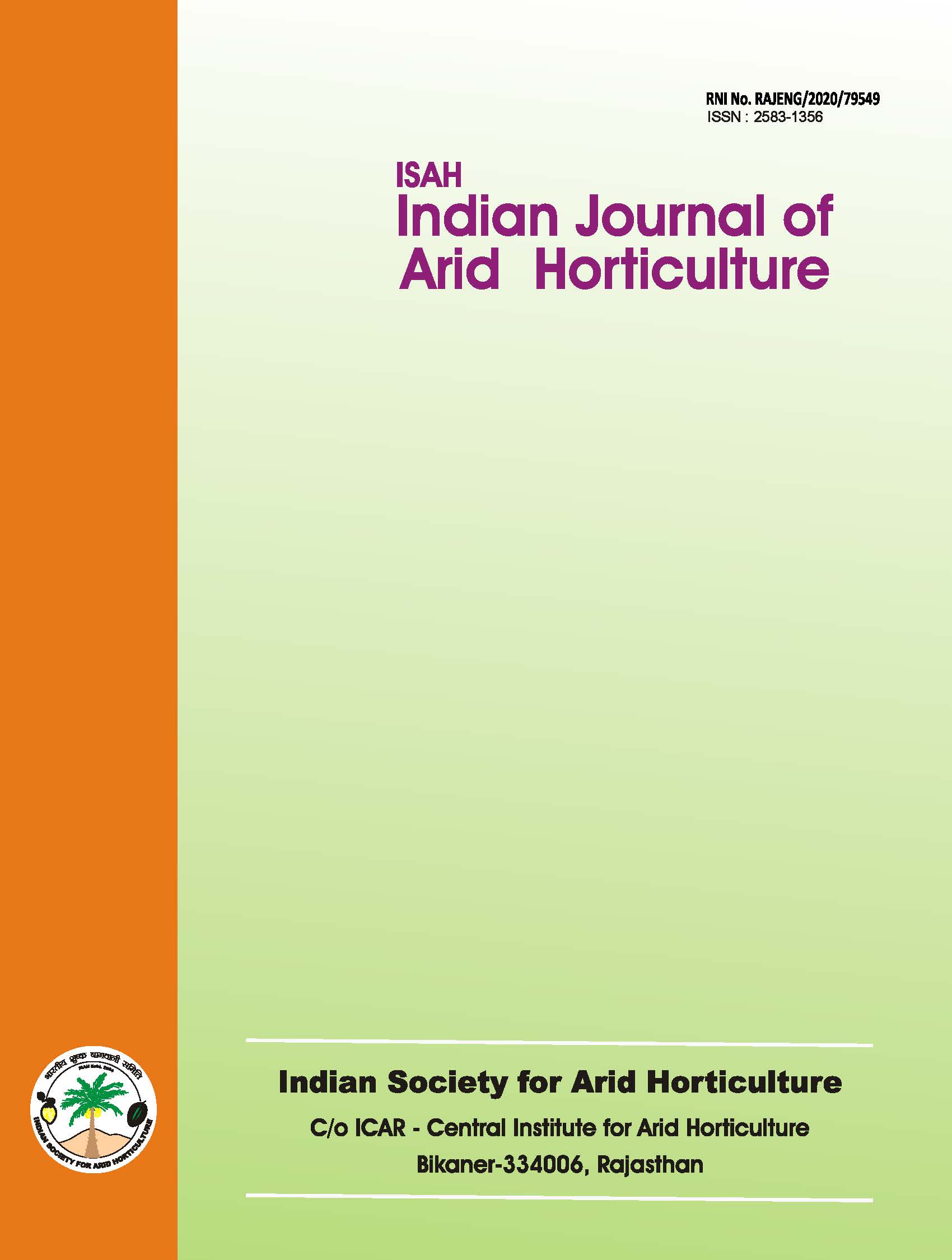Effect of Shoot Pruning on Yield and Fruit Quality of Jamun (cv. Goma Priyanka)
Keywords:
intensities, Syzygium cuminii SkeelsAbstract
Jamun (Syzygium cuminii Skeels) is an important fruit crop belonging to the family Myrtaceae. It is indigenous to India, Burma, and the Andaman Islands (Zeven and de Wet, 1982) and is available throughout the Indian plains, as well as in the Kumaon hills up to an altitude of 1,600 meters (Mishra et al., 2015). The fruits are used as an effective remedy for diabetes, heart disease, and liver disorders. Due to its multiple uses, jamun has emerged as a promising fruit crop in India (Singh et al., 2016). In Gujarat, jamun is commercially cultivated in the districts of Vadodara, Anand, Navsari, Kheda, and Junagadh. Most plantations in these areas consist of seedling-raised trees. However, farmers are increasingly adopting grafted planting material of the Goma Priyanka variety developed by the station.Jamun trees, whether seedling-raised or grafted, exhibit an erect growth habit, reaching heights of 25–30 meters, making harvesting and orchard management challenging. In the absence of proper canopy management, orchards become overcrowded, limiting access and reducing light penetration required for optimal photosynthesis, flowering, fruit set, and quality (Mishra and Goswami, 2016).Pruning has been employed as a technique to regulate tree size and shape, achieving a desirable canopy architecture while reducing foliage density by removing unproductive branches. To maintain a dwarf framework, the topping of the main stem at 4–6 meters is recommended, which facilitates easy harvesting. Studies have shown that pruning 50% of the annual extension growth after harvesting effectively reduces canopy size and improves fruit quality attributes (Singh et al., 2011).Pruning, when performed correctly, shapes the plant to optimize marketable yield. In Konkan Bahadoli jamun, different pruning intensities significantly increased marketable yield (Lawande et al., 2014). The fruit-bearing branches in jamun are distributed throughout the canopy, and fruits do not ripen uniformly. As a result, at least 3–4 pickings are required to harvest fully ripened fruits.Jamun fruits are delicate, with a thin peel, making hand-picking the only viable harvesting method. However, due to the tall nature of the tree, manual harvesting becomes labor-intensive, with 25–30% of fruits suffering mechanical damage. Being a non-climacteric fruit, jamun must be harvested fully ripe to ensure optimal quality. Therefore, managing tree canopy height through pruning is essential for efficient harvesting and maintaining fruit quality. Despite its advantages, pruning in jamun has not been widely adopted as a standard orchard management practice. In this study, different pruning intensities were imposed on mature bearing trees of Goma Priyanka to evaluate their effects on fruit yield and quality.Downloads
References
AOAC. 1990. Official Methods of Analysis, 17th edn. Association of Official Analytical Chemists, Washington, DC, USA.
Gomez, K. A., and Gomez, A. A. 1984. Statistical Procedures for Agricultural Research, 2nd edn. John Wiley and Sons Inc., New York.
Goswami, A. M., Saxena, S. K., & Kurian, S. 1993. High-density planting in citrus. In: Advances in Horticulture (Eds.) Chadha, K. L., and Pareek, O. P. New Delhi: Malhotra Publishing House, Vol. II, pp. 645–648.
Lawande, K. E., Nandankar, P. M., Dahi, N. V., and Parulekar, Y. R. 2014. Effect of pruning on flowering and yield of Jamun cv. Konkan Bahadoli. Journal of Plant Studies, 3(1): 114–118.
Mishra, D. S., Singh, A., Kumar, R., Singh, S., Singh, A. K., and Swamy, G. S. K. 2014. Jamun. In: Tropical and Subtropical Fruit Crops: Crop Improvement and Varietal Wealth (Ed.) Ghosh, S. N. New Delhi: Jaya Publishing House, pp. 375–387.
Mishra, D. S., and Goswami, A. 2016. High-density planting in fruit crops. HortFlora Research Spectrum, 5(3): 261–264.
Mishra, D. S., and Lal, R. L. 2013. Canopy management in overgrown litchi orchards for improving yield and quality. In: Canopy Management and High-Density Planting in Subtropical Fruit Crops (Eds.) Singh, V. K., and Ravishankar, H. Lucknow: Army Printing Press, pp. 225–228.
Mistry, P. M., and Patel, B. N. 2009. Impact of heading back plus paclobutrazol on rejuvenation of old and overcrowded Alphonso orchards. Indian Journal of Horticulture, 66(4): 520–521.
Serrano, L. A. L., Martins, M. V. V., Lima, I. de M., Marinho, C. S., and Tardin, F. D. 2008. Effect of pruning time and intensity on Paluma guava trees in Pinheiros, ES, Brazil. Revista Brasileira de Fruticultura, 30(4): 994–1000.
Singh, S., Singh, A. K., Singh, H. P., Bagle, B. G., and More, T. A. 2011. Jamun. ICAR, pp. 1–46.
Zeven, A. C., and de Wet, J. M. J. 1982. Dictionary of Cultivated Plants and Their Regions of Diversity: Excluding Most Ornamentals, Forest Trees, and Lower Plants. Centre for Agricultural Publishing and Documentation (Pudoc), Wageningen, pp. 1–11.
Singh, S., Singh, A. K., Appa Rao, Bhargava, R., Mishra, D. S., and Saroj, P. L. 2016. In: National Seminar on Noni and Medicinal Plants for Health and Livelihood Security, Lucknow, Dec. 3–4, 2016, pp. 52.

